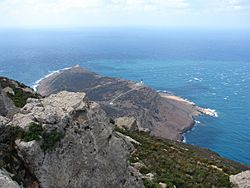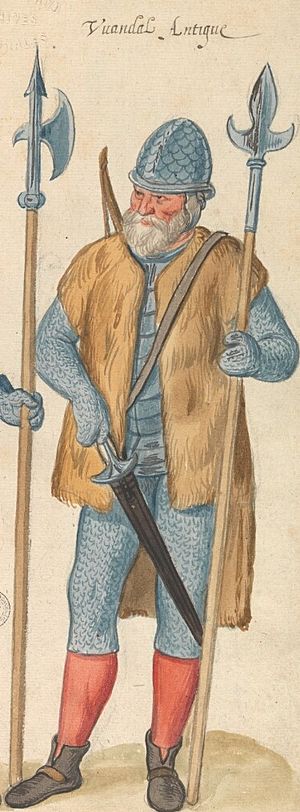Battle of Cape Bon (468) facts for kids
Quick facts for kids Battle of Cape Bon (468) |
|||||||
|---|---|---|---|---|---|---|---|
| Part of the Fall of the Western Roman Empire | |||||||
 |
|||||||
|
|||||||
| Belligerents | |||||||
| Vandal Kingdom | |||||||
| Commanders and leaders | |||||||
| Gaiseric | Basiliscus Marcellinus Heraclius of Edessa |
||||||
| Strength | |||||||
| Unknown number of men Unknown number of ships |
Procopius: 100,000 men Cedrenus: 1,113 ships Modern estimate: 50,000 men |
||||||
| Casualties and losses | |||||||
| Unknown | 10,000 100 ships |
||||||
The Battle of Cape Bon was a huge naval battle in 468 CE. It happened when the Western Roman Empire and the Eastern Roman Empire teamed up. Their goal was to attack the Vandal capital, Carthage. This invasion was one of the biggest sea attacks in ancient history. It involved 1,113 ships and over 50,000 soldiers and sailors.
The Roman fleet tried to land near Carthage, at a place called Cape of Mercury. Today, this is known as Cape Bon in Tunisia. Suddenly, the Vandal fleet attacked using special "fireships." These were old ships filled with flammable materials. They were set on fire and sent crashing into the Roman ships. This surprise attack caused a lot of confusion and damage. The Vandals then attacked with their own warships. They sank over 100 Roman ships. About 10,000 Roman soldiers and sailors died in the battle. The Roman forces were too scattered and weak to land their troops. This led to their complete defeat.
Many historians believe this battle was the last chance for the Western Roman Empire to survive. Without the rich resources from the Roman province of Africa, the Western Empire could not afford a strong army. This made it harder to fight off its many enemies.
Contents
Why the Battle Happened
The Rise of the Vandals
By 435 CE, the Vandals, led by their king Gaiseric, had created their own kingdom in North Africa. This area was once a rich Roman province. In 455 CE, Gaiseric's forces attacked and looted Rome. Rome was the capital of the Western Roman Empire. The empress and her daughters were taken as prisoners. This event showed how powerful the Vandals had become.
The Roman Plan
The Roman emperors decided to launch a massive attack to defeat the Vandals. Emperor Leo of the Eastern Roman Empire, Emperor Anthemius of the Western Roman Empire, and General Marcellinus worked together. Marcellinus was a powerful general who controlled the region of Illyricum.
The main plan was for General Basiliscus to sail directly to Carthage. At the same time, General Marcellinus would attack and capture Sardinia. A third army, led by Heraclius of Edessa, would land on the coast of Libya. All these forces were supposed to meet up in Sicily first. Then, they would launch their attacks from there.
A Huge Expedition
This was a truly massive military operation. Ancient writers and modern historians have different numbers for how many ships and soldiers were involved. Some say there were 1,113 ships. Others estimate around 50,000 soldiers and sailors in total. The cost of this expedition was also enormous. It cost a huge amount of gold and silver. This shows how important it was for the Romans to defeat the Vandals.
The Battle Unfolds
The Surprise Attack
Before the main battle, Marcellinus and Heraclius had already captured Sardinia and parts of Libya. Then, Basiliscus's huge fleet arrived near Cape Bon, not far from Carthage. Gaiseric, the Vandal king, asked Basiliscus for five days to discuss peace terms. This was a trick. During these talks, Gaiseric secretly prepared his fleet for a surprise attack.
The Vandals filled many of their old ships with oil, wood, and other things that burn easily. These were the "fireships." In the middle of the night, they sent these burning ships towards the Roman fleet. The Roman ships were anchored and not expecting an attack. The fireships caused chaos and panic. Many Roman ships caught fire. The Vandal warships then followed up, attacking the confused Roman fleet. Basiliscus, the Roman commander, fled the battle.
A Heroic Stand
Even though the battle was going badly, one Roman officer showed great bravery. His name was Joannes, and he was Basiliscus's second-in-command. He stood on his ship's deck, fighting fiercely against many Vandal attackers. He killed many enemies. When he saw that his ship was about to be captured, he refused to surrender. He jumped into the sea while still wearing his heavy armor. He chose to drown rather than be captured by the Vandals. His last words were that he would "never come under the hands of dogs."
After the Battle
Roman Defeat
The Battle of Cape Bon was a disaster for the Romans. About half of their huge fleet was either burned, sunk, or captured. The rest of the ships fled, following Basiliscus. The entire expedition had failed. Heraclius managed to retreat through the desert. Marcellinus went back to Sicily. However, Marcellinus was later killed by one of his own captains. Some people believe this was arranged by a powerful Roman general named Ricimer. The Vandal king Gaiseric was surprised and happy that the Romans had removed one of his strongest enemies themselves.
Basiliscus's Fate
After his defeat, Basiliscus returned to Constantinople. He hid in the famous church of Hagia Sophia to avoid the anger of the people and the emperor. Eventually, with the help of the empress, Basiliscus was forgiven. His punishment was to be sent away to a place called Heraclea Sintica.
The End of an Empire
The Roman Empire's treasury was now empty after this huge and failed expedition. Many historians believe that this battle was the last real chance for the Western Roman Empire to save itself. After this defeat, the Western Empire only controlled Italy and Sicily. Without the rich income from the former Roman province of Africa, the Western Empire could not afford to keep a strong army. This made it much harder for them to defend against their many enemies. The Western Roman Empire would fall completely just a few years later.
See also
 In Spanish: Batalla de Cabo Bon (468) para niños
In Spanish: Batalla de Cabo Bon (468) para niños


